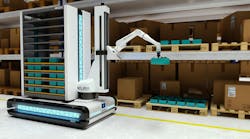In his game-changing book on business, The World Is Flat, Thomas Friedman expounded on the ten “flatteners” that would eventually drive the trend toward the “level playing field” that’s synonymous with his work’s title.
Workflow software, outsourcing and supply chain, all pretty radical ideas at the time, have all come to pass, along with other forces in the machine tool world.
Today, we have an aging workforce in America and fewer job positions in the “traditional” manufacturing sector to replace them.
Further challenging this scenario is the disappearance of “tribal knowledge” in favor of more informational and technological solutions housed in everything from a machine controller to a smart phone.
This leaves the manufacturing sector at a decidedly precarious crossroad, where unskilled labor is simply becoming unnecessary in the age of robotics and intelligent machines, while the job shop setup experts and machine maintenance personnel, so vital in bygone days, are now tasked to set-up and service an entirely new generation of machines and manufacturing cells.
Even more challenging, the emergence of the digital factory, with its blending of the virtual and the real, has already taken hold of large sectors in the American economy, including automotive, aerospace, medical part manufacturing and others.
Where does this landscape find room for the worker of the future? I would propose three ideas here.
1. The absolute need for education is, without question, our most critical driver for remaining competitive.
The workforce of tomorrow must be trained, not for the jobs in the market today, but for the jobs that will emerge as critical to the operation of that digital factory in the future.
And, so there is no question, I’m referring to big production departments and small shop floors alike.
To remain competitive, every link in the supply chain will be called upon to hire better, smarter and more flexible workers at every level of their companies — from the product lifecycle managers who look at the entire lifespan of the item being created, to the design engineers who live in the virtual link between the concept and created product, to the manufacturing and production engineers who must constantly evaluate the scope and scale of their facilities and their equipment to make the right decisions that will keep the factory on track, to all the procurement and logistics professionals who will be needed to maintain the proper materials flow through the factory for maximum production and economic viability… all will be vital to the success of the overall operation.
This will be as true for the fastener company and mold-and-die shop as it already is for the aircraft builder, the automobile manufacturer and the orthopedic device maker.
Knowing the challenges and how to respond will be critical in educating their next generation of workers. This is also a time to “train the trainers” for the market conditions their students will encounter.
2. Collaboration among the players in a market will be the next key to success.
Our company is sponsoring the Digital Manufacturing and Design Innovation Institute (DMDII), a major effort in Chicago, for example, where companies of all types are joining forces to conceptualize and implement that digital factory, where, for our purposes in the machine tool business, the fusion of CAD/CAM/CNC and quality control will be overlaid with the product lifecycle management outlook to produce the most cost-effective and efficient manufacturing process for quality products in the market.
Friedman’s level playing field factors here, as the acceleration of robotics for both machining and material handling enters the picture and acts as a counter-balance to the labor-intensive, but very low-cost markets on the planet.
As a corollary, the importance of mechatronics in the machine building industry must be emphasized, as it already plays a key factor in the design and construction of the machines for that digital factory.
Machines will not only need to make the part, they will need the ability to see it, measure it, compare it to the design, make changes on the fly in an entirely electronic mode with no more trial-and-error and, finally, log all the production and workflow data, uploading it to a bus for non-stop statistical analysis of the factory or factories, in the case of multi-nationals.
3. A keen awareness of the new technologies will be vital.
As additive manufacturing alone, in all its seven (currently) forms, continues to change the look of American manufacturing at the speed of light, companies must be in line with that development and others such as the hybrid machine, which fuses conventional chip-cutting with perhaps laser sintering or other additive methods, to produce a finished part.
Speed, the one constant goal of OEMs since the day when Henry Ford had his lightbulb moment with the conveyor line for assembly of his cars, will be critical not only in the machining and assembly, but also in the design, modification implementation and logistical handling of component parts, as they arrive on that assembly line.
Finally, I suggest you begin to see the Industrie 4.0 concept as something more than a nice catch-phrase.
It is already impacting your business, in ways you might not yet see, but soon will. Just be sure you soon see them in your factory, not your competitor’s.
One quick suggestion is to visit a trade show in your market along with a second show, unrelated to your market. It might make you see your corner of that flat Earth with a whole new perspective.
Sascha Fischer is the Business Segment Manager for Siemens Industry, Inc., Motion Control Business / Machine Tool Systems.










